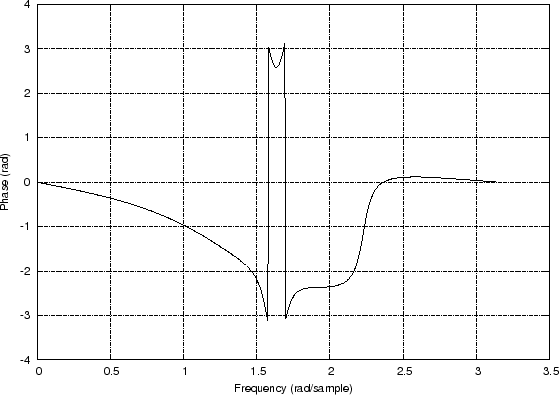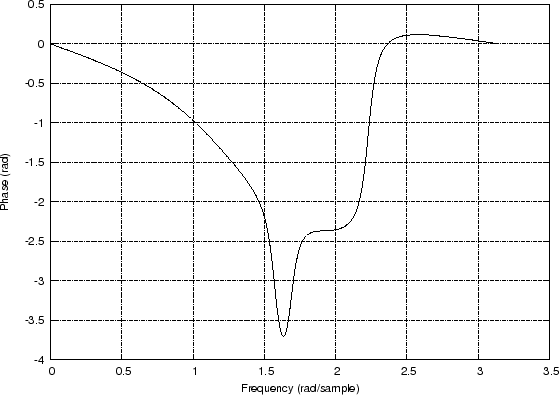In working with phase delay, it is often necessary to ``unwrap''
the phase response
![]() . Phase unwrapping ensures that
all appropriate multiples of
. Phase unwrapping ensures that
all appropriate multiples of ![]() have been included in
have been included in
![]() . We defined
. We defined
![]() simply as the complex
angle of the frequency response
simply as the complex
angle of the frequency response
![]() , and this is not sufficient
for obtaining a phase response which can be converted to true time
delay. If multiples of
, and this is not sufficient
for obtaining a phase response which can be converted to true time
delay. If multiples of ![]() are discarded, as is done in the
definition of complex angle, the phase delay is modified by multiples
of the sinusoidal period. Since LTI filter analysis is based on
sinusoids without beginning or end, one cannot in principle
distinguish between ``true'' phase delay and a phase delay with
discarded sinusoidal periods when looking at a sinusoidal output at
any given frequency. Nevertheless, it is often useful to define the
filter phase response as a continuous function of frequency
with the property that
are discarded, as is done in the
definition of complex angle, the phase delay is modified by multiples
of the sinusoidal period. Since LTI filter analysis is based on
sinusoids without beginning or end, one cannot in principle
distinguish between ``true'' phase delay and a phase delay with
discarded sinusoidal periods when looking at a sinusoidal output at
any given frequency. Nevertheless, it is often useful to define the
filter phase response as a continuous function of frequency
with the property that
![]() or
or ![]() (for real filters). This
specifies how to unwrap the phase response at all frequencies
where the amplitude response is finite and nonzero. When the
amplitude response goes to zero or infinity at some frequency, we can
try to take a limit from below and above that frequency.
(for real filters). This
specifies how to unwrap the phase response at all frequencies
where the amplitude response is finite and nonzero. When the
amplitude response goes to zero or infinity at some frequency, we can
try to take a limit from below and above that frequency.
Matlab and Octave have a function called unwrap() which
implements a numerical algorithm for phase unwrapping.
Figures 7.4(a) and 7.4(b) show the effect of the
unwrap function on the phase response of the example elliptic
lowpass filter of §7.5.2, modified to contract the zeros from
the unit circle to a circle of radius ![]() in the
in the ![]() plane:
plane:
[B,A] = ellip(4,1,20,0.5); % design lowpass filter B = B .* (0.95).^[1:length(B)]; % contract zeros by 0.95 [H,w] = freqz(B,A); % frequency response theta = angle(H); % phase response thetauw = unwrap(theta); % unwrapped phase responseIn Fig.7.4(a), the phase-response minimum has ``wrapped around'' to the top of the plot. In Fig.7.4(b), the phase response is continuous. We have contracted the zeros away from the unit circle in this example, because the phase response really does switch discontinuously by

Phase
Response 
Unwrapped Response
|